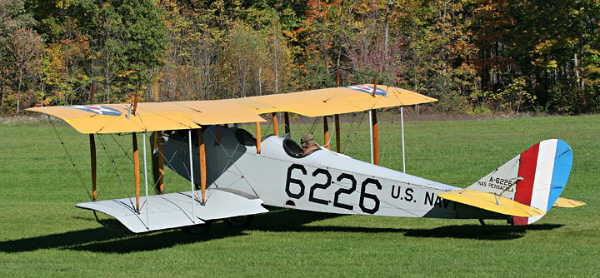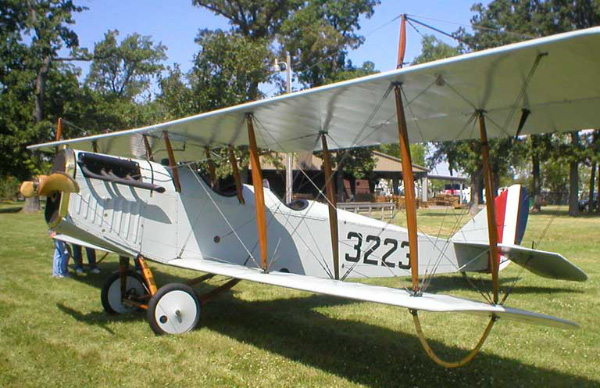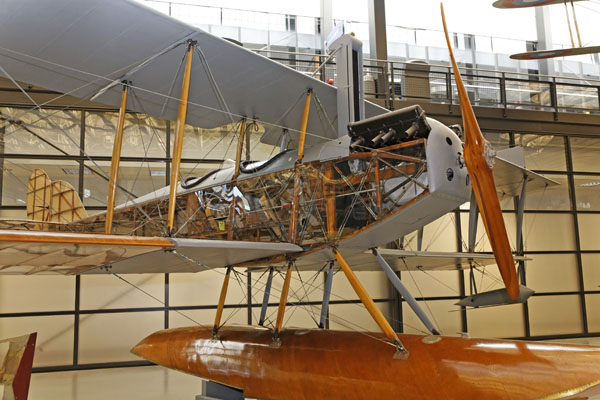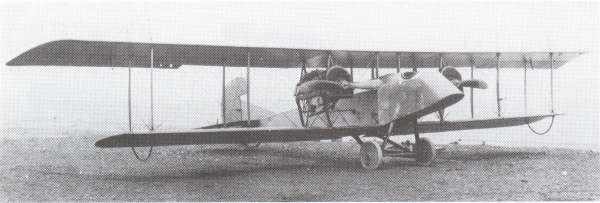
|
 |
The Curtiss JN-4 Jenny |
 |
 |
 |
 |
 |
|---|---|---|---|---|---|---|---|
 |
 |
 |
 |
 |
|||
 |
||
|
In 1914, Glenn Curtiss
realized that the pusher aircraft was obsolete and that the Europeans were preeminent in tractor designs. Curtiss traveled to England for ideas and while visiting the Sopwith Aviation Company, he met a young engineer by the name of Benjamin Douglas Thomas. He asked Thomas to design a tractor airplane for him and Thomas came up with the Model J. (In later years, Thomas would also be involved in the design of the H-1 America.) The first flight of the Model J was May 10, 1914, and achieved a speed of 85 mph, making it the fastest plane in the United States. Curtiss was also working on his own tractor design, the Model N, and the two models were combined, incorporating the best characteristics of the Curtiss J and N models. While production of the N model continued, the J Model was dropped in favor of the JN or Jenny.
In spite of its docile appearance, the Jenny was the first American airplane to be used in war. In 1916, Pancho Villa led a group of bandits into Columbus, New Mexico and attacked the US 13th Calvary Regiment. They seized horses, military supplies and finally burnt down half the town. In response to the raid, President Wilson sent 5,000 troops under General John J. Pershing to capture Villa. On March 16, 1916, Pershing led the 1916-17 "Punitive Expedition" into Mexico and JN-3s were used for border patrol, flying out of Brownsville, Texas with the First Aero Squadron supplying air support as observers. However, the expedition failed due to lack of supplies and Pancho Villa was never captured. |
| The First Aero Squadron operation in Mexico was largely considered a fiasco. The JN-2s were plagued with mechanical problems and poor performance. Pilots found the JN-2s virtually uncontrollable and pilots were refusing to fly the airplane.1 After many complaints, one JN-2 was sent to the Massachusetts Institute of Technology for wind tunnel testing and it was confirmed that the airplanes were unstable. With his reputation at stake, Glenn Curtiss modified the JN-2s with a new wing design, a larger tail surface and new engines resulting in the JN-3. However, the added weight would drastically lower the operational ceiling making it impossible for the First Aero Squadron to climb the Sierra Mountains to pursue Pancho Villa.2 |
|
The early Jennys used a shoulder yoke to operate the ailerons, but another modifiction to the the JN-3 was the Deperdussin control system which incorporated a control wheel for the ailerons, and a foot bar to operate the rudder.3

Afterwards, Jennys were used mostly as trainers, as it was simply outclassed by European fighters of the time. It became the principal primary trainer for the US and Canadian Army during World War I and was also used by the English and US Navy. About 95% of American and Canadian pilots completed part of their training in a Jenny. By the time the U.S. entered the war in 1917, production of the Jenny had reached the JN-4D model. The D model was built in the greatest numbers and was powered by the Curtiss OX-5 engine. The JN-4 Canadian built models, known as the Canuck, introduced the control stick system and was eventually adopted on the USA built JN-4D. Other new features included: |
| • | Ailerons on the upper wings only. | |
| • | Cut-outs on the lower wing to improve visibility. | |
| • | Six degrees down-thrust of the Curtiss OX-5 engine. |

In 1917, new Jennys were sold to the government for $8,160, but by 1919, reconditioned Jennys purchased from the US Army by Curtiss were selling for $4,000 and OX-5s were selling for $1,000. By the mid 1920s, a rebuilt Canuck had dropped to an average price of $2,400. Towards the end of their careers, Jennys could be bought for as little as $500 among private owners, and by 1928, an unused OX-5 could be purchased for a standard price of $250. With such a glut of surplus military aircraft on the market, it was difficult for manufacturers to compete with the production of new aircraft.4 The JN-4H (Model E-1), powered by a 150 hp Wright built Hispano-Suiza was an advanced trainer and was the same model that Charles Lindbergh trained in as an US Army Cadet.5 With a top speed of 93 mph, the JN-4H was a more powerful aircraft providing higher performance, which made the transition from trainer to fighter less demanding. The JN-4H had a beefed up fuselage and a larger nose radiator. The fuel capacity was increased from 21 to 31 US gallons by installing an additional wing tank in the upper wing center section.6

The years after World War I, from 1920 to 1926, is known as the Jenny Era, where hundreds of military pilots, and those who first learned to fly in a Jenny, purchased hundreds of converted US Army Jennys and embarked on a career in Flying Circuses and as Barnstormers, with the JN-4 being the most preferred model. The Jenny, along with the J-1 Standard, was a great platform for wing walking. The maze of struts, a single axle between the wheels, the slow speed and the king-post on the upper wing made it a great platform for wing walking. Without the king-post to hold on to, transferring from one plane to another would have been near impossible. The Jenny Era began fading in 1925 as new newer and more efficient aircraft, such as the Curtiss Hawk, came into production. The final death knell for the Jenny came in 1927 when new regulations for airworthiness, maintenance and pilot licensing requirements came into effect. The Jenny was not able to meet the new directives and by 1930, the Jenny was illegal to operate in most parts of the United States. It wasn't until the 1950s when Jennys came back into acceptance with the Vintage Airplane Movement. By 1976, there were only four Jennys in airworthy condition and Jennys now operate under Experimental License status.7

The Curtiss N-9 was a seaplane variant of the JN-4B used as a military trainer during the First World War. As a seaplane, the N-9 was equipped with a single central pontoon mounted under the fuselage, along with small floats fitted under each wingtip. Design changes included: |
| • | A longer fuselage. | |
| • | Larger tail surfaces. | |
| • | A larger wingspan expanded by 10 feet. | |
| • | Stabilizing fins added to the top of the top wing. |
|
The N-9 used the Deperdussin control system utilizing a control wheel for the ailerons and a foot-bar for the rudder. The N-9 was initially powered by a 100 hp Curtiss OXX engine. The US Navy was the principal user and ordered a total of 560 N-9s, most of which were N-9H models powered by the 150 hp Wright-Hispano
engine.

Another variant was the Twin JN. It was an enlarged twin-engine version of the JN-4, powered by two opposite rotating OXX-2 engines. Lateral stability was enhanced by increasing the tail area, with the installation of a modified R-4 rudder. It remained a two seat machine, but the observer's seat was moved to the nose of the aircraft. It saw brief service on the Mexican border in 1916. A total of eight aircraft were built. Although it had a British foundation, the Curtiss Jenny is considered American as apple pie. It was one of the most famous airplanes produced by the Curtiss Aeroplane and Motor Company and no other WWI airplane had been built in greater numbers. By the time the war had ended, more than 10,000 Jennys had been delivered.8 |
| Specifications: | ||
|---|---|---|
| Curtiss JN Jenny | ||
| JN-4D | JN-4HG | |
| Dimensions: | ||
| Wing span: | 43 ft 7-3/8 in (13.29 m) | 43 ft 7-3/8 in (13.29 m) |
| Length: | 27 ft 4 in (8.33 m) | 27 ft 4 in (8.33 m) |
| Height: | 9 ft 10-5/8 in (3.01 m) | 9 ft 10-5/8 in (3.01 m) |
| Weights: | ||
| Empty: | 1,390 lb (630 kg) | 1,625 lb (737 kg) |
| Gross Weight: | 1,920 lb (870 kg) | 2,269 lb (1,029 kg) |
| Performance: | ||
| Maximum Speed: | 75 mph (120 km/h) at sea level. | 91 mph (146 km/h) at sea level. |
| Cruise Speed: | 60 mph (97 km/h) | 75 mph (121 km/h) |
| Service Ceiling: | 6,500 ft (1,981 m) | 7,500 ft (2,286 m) |
| Range: | 155 miles (250 km) | 155 miles (250 km) |
| Range: | 2 hrs. 15 minutes | 2 hrs. 15 minutes |
| Powerplant: |
One Curtiss OX-5 V8, 90 hp (67 kW), water cooled engine. |
One Wright-Hispano V8, 150 hp (112 kW), water cooled engine. |
| Armament: | One fixed Marlin and one or two flexible Lewis machine-guns. | |
Endnotes:
|
1. Benjamin D. Foulois and C.V. Glines. From the Wrights to the Astronauts, The memoirs of Major General Benjamin D. Foulois New York: McGraw-Hill Book Company, 1968. 120. 2. Herbert M. Mason, Jr. The United States Air Force, A Turbulent History. New York: Mason/Charter, 1976. 25. 3. Louis S. Casey. Curtiss, The Hammondsport Era, 1907 - 1915. New York: Crown Publishers, 1981. 194. 4. Murray Rubenstein & Richard M. Goldman. To Join with Eagles. A complete illustrated history of Curtiss Wright aircraft from 1903 to 1965. Garden City, New York: Doubleday & Company, Inc. 1974. 39. 5. Charles A. Lindbergh. We. New York: G. P. Putnam's Sons, 1927. 108. 6. Peter M. Bowers. Curtiss Aircraft, 1907 - 1947. Annapolis, Maryland: Naval Institute Press, 1987. 159. 7. Ibid. 148. 8. Murray Rubenstein & Richard M. Goldman. 39. |
.
© Larry Dwyer. The Aviation History Online Museum.
All rights reserved.
Created March 30, 2010. November 11, 2013.